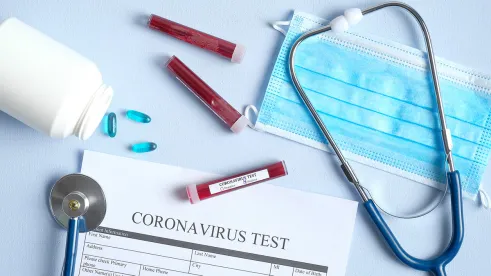On Wednesday April 22, 2020, the U. S. Department of Human Health and Services (HHS) unveiled its plan to disperse an additional $70 billion in COVID-19 funding authorized by the Coronavirus Aid Relief and Economic Security (CARES) Act. On Friday April 25, 2020, an additional $75 billion was appropriated to the provider relief fund by the CARES Act 3.5. The funding, totaling $175 billion, is to be used to “prevent, prepare for, and respond to coronavirus,” and to reimburse eligible health care providers for “healthcare related expenses or lost revenue attributable to coronavirus,” as stated in the CARES Act (the CARES Act Provider Relief Fund).
On April 10th, HHS distributed, via direct deposit, an initial $30 billion of the CARES Provider Relief Fund to eligible health care providers. However, up until Wednesday, it was unclear how and when the remaining $70 billion would be allocated and distributed. As part of last week’s announcement, HHS Secretary Alex Azar II stated, “we’re putting out all these funds as quickly as possible, as transparently as possible, to those who are suffering the most from this situation. The health care providers on the frontlines of the pandemic are heroic, and President Trump recognizes that every American health care provider has pitched in for this fight in some way. We will continue using every regulatory and payment flexibility we have to help providers continue doing their vital work until we’ve defeated this virus.”
To achieve these goals, HHS is allocating a portion of the $100 billion to pay health care providers, at Medicare rates, for care provided to the uninsured. Such claims can go back to February 4, 2020, when the Centers for Medicare & Medicaid Services (CMS) created specific codes for COVID-19 related procedures. The Health Resources & Services Administration (HRSA) is responsible for managing the new program and launched a website late last week dedicated to this new program.
In addition, HHS will distribute the remaining CARES Provider Relief Fund as follows:
-
General Allocation: Building upon the initial $30 billion already distributed, HHS will distribute an additional $20 billion to health care providers. Unlike the first $30 billion, in which payments were determined based upon providers’ 2019 Medicare fee-for-service revenue, payments from this $20 billion allocation will be determined based upon providers’ 2018 net patient revenue from all sources. Per HHS, this payment methodology seeks to “make up” for those providers who received small payments under the initial disbursement because such providers do not have large Medicare fee-for-service revenues (e.g., pediatricians). Eligible providers are required to submit certain information about their revenue for the $20 billion remaining under the General Allocation, providers must submit additional information through the Provider Relief Fund attestation portal. The portal is officially open for those providers who received a distribution of the original $30 billion allocation. Providers must submit: (1) “Gross Receipts or Sales” or “Program Service Revenue” as submitted on its federal income tax return; (2) estimated revenue losses in March 2020 and April 2020 due to COVID; (3) a copy of the provider’s most recently filed federal income tax return; (4) a listing of the Taxpayer Identification Number (TINs) any of the provider’s subsidiary organizations that have received relief funds but that DO NOT file separate tax returns.
Like payments from the initial $30 billion, eligible health care providers for the additional $20 billion must submit an attestation confirming receipt of funds and agree to certain terms and conditions, which include: (1) a balance billing prohibition; (2) mandatory reporting of certain information as defined by HHS, such as a detailed list of all projects or activities for which large covered funds were expended or obligated; and (3) an assertion that the funds are to be used for the prevention, treatment, and response to COVID-19. Recipients must also certify that the payment will not be used to reimburse expenses or losses that have been reimbursed from other sources. Payments will be distributed directly to providers on a weekly, rolling basis, as revenue information is validated. Applications will be processed in batches every Wednesday at 12:00 p.m. ET.
-
Targeted Allocation: HHS will distribute $10 billion to providers in areas suffering the most impact from COVID-19. In an effort to determine how this $10 billion is distributed, HHS has requested that hospitals in such highly-impacted areas submit the following “simple pieces of” information: (1) TIN; (2) their National Provider Identifier (NPI); (3) their number of intensive care unit (ICU) beds as of April 10; and, (4) their number of COVID-19 admissions from January 1 to April 10. The original deadline to submit this information was April 23, but after consulting with hospitals and hospital associations HHS extended the deadline to April 25 at 3:00 p.m. ET. This targeted allocation is only available to hospitals. HHS anticipates funds will be distributed to high-impact areas as early as next week.
HHS advised that sharing the above data should take less than five minutes. While the requested information may seem straightforward to HHS, the language is ambiguous and subject to multiple interpretations, which could significantly impact the distribution of these targeted funds depending upon how hospitals interpret the above requirements. For example, “the number of ICU beds” could be interpreted to mean state licensed ICU beds, staffed regular ICU beds, or state licensed ICU beds and staffed surge ICU beds. Clearly, the numbers could be quite significant depending upon how hospitals interpret “ICU beds.” HHS has not provided further guidance as to the above requested data.
-
Rural Allocation: HHS will distribute $10 billion to rural health clinics and hospitals. Payments will be determined on the basis of operating expenses, using a methodology that distributes payments proportionally to each facility and clinic. As a condition to receiving these funds providers must agree not to seek collection of out-of-pocket payments from a presumptive or actual COVID-19 patient that are greater than what the patient would have otherwise been required to pay if the care had been provided by an in-network provider.
HHS expects to begin distributing payments to eligible providers as early as this week.
-
Tribal Allocation: In recognizing the strain caused in responding to COVID-19, HHS will distribute $400 million to Indian Health Services (IHS). Payments will be determined on the basis of operating expenses and payments will be distributed as early as next week. HHS notes that this complements other funding provided to IHS.
HHS’s dedicated CARES Provider Relief Fund webpage provides some information regarding the above relief funds. However, the information is incomplete and health care provider greatly desire clarification which would enable them to better understand whether and how they may use these relief funds. At this time, HHS has not issued formal guidance or further details, beyond what is available on its website, such as defining the reporting requirements and process or defining the costs which are eligible for reimbursement through the CARES Provider Relief Fund. While HHS has indicated that additional details on other targeted groups of hospitals and providers that will receive a share of the remaining $100 billion funds are forthcoming, it is unclear when such guidance will be available. Foley is tracking the situation closely and will continue to keep the community apprised of relevant related developments.





 />i
/>i
